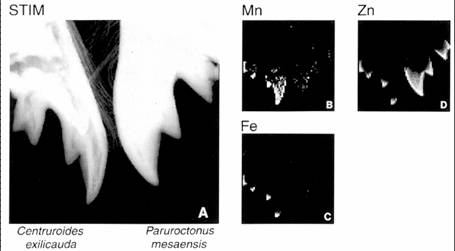Occurence:
Enriched structures and phylogenetic distribution.
Different Elements in Similar Structures:

Fang and marginal teeth of the spider, Araneus diadematus Zn: 15%; Mn 4%; Cl 3%
Not Just Mouth Parts:

Tarsal claws of buthid and non-buthid scorpions
The following is a Scorpion sting, Hadrurus arizonensis:

Tomographic section:

Marine Worms:
From bottom left, up, then to the right you see the Paragnaths, Nereis brandti; Jaw, Glycera convoluta and the Jaw, Nereis brandti.

Below you see Fe, Cu, Br, and finally Zn deposits in the jaw of a marine worm.




Taxonomic Patterns:

The above picture illustrates Differences between chelicerae of buthid and non-buthid scorpions.

Buthidae conformed to pattern B, all other scorpions to pattern A (37 individuals from 15 species in 6 families were examined).
Distribution in the Higher Taxa:
Zn has been found in high concentrations in “tools” of:
- 136 species in 5 orders of insects
- 4 species in 1 order of centipedes
- 30 species in 6 orders of arachnids
- 12 species in 1 order of polychaete worms
- 2 species in 1 order of nemertean worms
Br (sometimes with Zn) predominates in the examined:
- Crustaceans
- Pycnogonids
- Horseshoe crabs
- Priapulids
Summary of Distribution Patterns
(in arthropods and annelids):
- Found only in structures that contact the environment.
- Found in organisms that can produce Ca biominerals.
- No strong correlations with habitat or behavior have been found.
- Only rare differences between species within a family.
